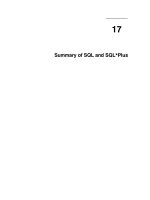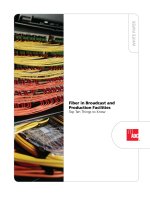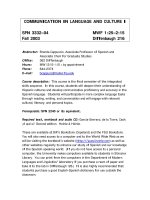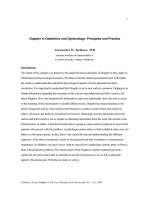Tài liệu Differentiation in Health and Physical Education doc
Bạn đang xem bản rút gọn của tài liệu. Xem và tải ngay bản đầy đủ của tài liệu tại đây (355.64 KB, 26 trang )
Differentiation in Health and Physical Education
By Joanne Walsh, Acting Coordinator of H&PE Halton District School Board
There are few areas where diversity is more apparent than in a
Health and Physical Education class. Students enter classes with
vastly different and varied skill sets, levels of confidence and
interests. It is a challenge to engage all of these students, be it in
the gym, during fitness activities or in the health classroom.
Building the key elements of differentiation into planning
increases the teacher’s ability to engage all students in learning.
As Health and Physical Educators, focusing on differentiation
does not mean an entire shift from present practice; it means
continuing to strengthen our approach to teaching and learning
by making small changes in current practice to enhance student
learning.
Differentiation is not an initiative, a program or the latest
innovative teaching strategy. Differentiation requires a shift
from teaching the subject to teaching each child. It begins with
placing the student at the centre of learning, respecting that students have diverse learning needs
and planning lessons in response to those needs. The guiding elements of differentiation provide
the framework for effective instruction “…that is responsive to the learning preferences, interests
and readiness of individual learners.” (Differentiated Instruction Teacher’s Guide: Getting to the
core of teaching and learning. Ontario Ministry of Education, 2007) “While it is true that
differentiated instruction is responsive to the individual learner, it does not involve individual
lesson plans. Rather it may mean a teacher offers individuals choice from a limited range of
options, or clusters students according to their learning preferences and provides a few different
ways to process new material. (Start Where They Are: Differentiating for Success with the Young
Adolescent. Karen Hume, 2008) Teachers may differentiate the process by which students learn
the content of the curriculum or the product through which students demonstrate their learning.
As Carol Ann Tomlinson writes, “…differentiating instruction means…that students have
multiple options for taking in information, making sense of ideas, and expressing what they
learn.” (How to Differentiate in Mixed-Ability Classrooms. ASCD, 2001)
Health and Physical Education
The best place to start on the road to differentiation is building a positive and inclusive learning
environment which fosters mutual respect for all learners where students encourage and support
each other. The key to differentiation is to know your students as individuals. No two people are
alike or learn in exactly the same way, at exactly the same pace so it is important to begin by
acknowledging the uniqueness of each child in your class and validating that each child makes a
valuable contribution to the learning process. “Teachers who recognize the unique strengths and
weaknesses of adolescents and still make them feel that they belong provide the most critical
support of all.” (Dr. Bruce Ferguson, Sick Kids, 2007)
Building a supportive learning classroom begins with the teacher modeling inclusiveness and
continues as students work together to achieve their learning goals in a variety of settings.
Students work in flexible groupings, while engaged in respectful tasks, which are designed based
on student readiness and provide appropriate challenges. When planning a new activity in the
gymnasium, teachers should consider the following questions: What assessment tool will I use to
determine the readiness level of my students (formative assessment)? Can my students be
divided into three or four distinct ability groupings? What drills or stations will I create to
provide an appropriate challenge for students in each of the groupings? When will my students
move to the next level of challenge? How will the structure of the activity promote cooperation
and mutual respect and inclusiveness? When will it be important to have students of similar
ability work together? When will it be important for students of diverse abilities to work
together?
A differentiated lesson accounts for the readiness level of each student. Prior experience with an
activity gives students a firm starting point and leads to their success. However, students who
lack these experiences need to be introduced to the activity in an enjoyable, engaging way to set
a positive context for their learning. Beginning with modified versions of an activity/sport
promotes inclusiveness, engages all students and creates a positive attitude toward the activity.
The modified versions should also be structured so teachers can assess the skill level of each
student. The teacher can then create playing opportunities and drills to address student readiness.
Consider any Invasion/Territory game (e.g., soccer, basketball, field hockey, ball hockey) for
which students need to acquire sending, receiving and travelling skills. Recognizing that students
have differing levels of readiness, the teacher can create a series of stations in a circuit format,
each ranging in degree of difficulty. This is known as Tiering. Students then choose their starting
point in the circuit. As one version of the skill is mastered, students move to the next level of
difficulty. The secret is that each works on developing the same basic skill e.g., dribbling. The
first station may involve dribbling in a straight line, the second may involve dribbling between
cones and the third may be dribbling against a defender. In each station, the students are
practicing the same skill of dribbling; however, each student is challenged to succeed based on
his/her own readiness level. Tiering allows students to progress to greater levels of difficulty at
their own pace.
Knowing the learning profile and interests of your students is also an essential element in
planning for differentiation. Learning inventories may be used to help students understand how
they prefer to process information, their intelligence preferences, whether they prefer to learn in
a group setting or through independent inquiry, or their ability to learn through oral, visual or
kinesthetic experiences. Additionally, a student’s interest peaks his/her motivation to explore
ideas and concepts. Thus, the goal of differentiating lessons for different learners with varying
interests is to offer a variety of choices so students may learn in ways that work best for them
about topics of interest within the scope of the curriculum. The end result being an improvement
in student learning.
Tools for Differentiation
A great motivational tool for students as they provide opportunities to explore facets of a topic
that are of particular interest, are choice boards. These connect the learning to their own lives,
allowing a sense of ownership and commitment to what they are learning. Choice boards focus
learning on a particular aspect of the content and/or allow students to choose the way they
demonstrate their learning (written, verbal or performance tasks). Created to use Gardner’s
Multiple Intelligences, each square on the choice board requires students to explore a concept or
demonstrate their learning using different intelligences. For example a choice board used to
reinforce fitness concepts may have students create a word web for the fitness center wall which
illustrates the key concepts of health-related fitness and their relationship to personal health
(Verbal-Linguistic intelligence), or design a fitness plan that focuses on improving health-related
fitness (Visual-spatial). A choice board may also be used to design tasks by which students
demonstrate their understanding of concepts using their preferred intelligence. This lends itself
particularly well to healthy living where students may create posters or mind maps, write
journals, raps or poems or perform skits to demonstrate their understanding of a health concept.
Cubing is a second powerful differentiation tool that provides a new twist on question asking and
answering, and works well in a health and physical education setting. It may be used to; address
readiness, activate student knowledge, review and summarize previous lessons, and assess
learner preference/interest. A cube is created with a different question, task or activity on each
side of it. A standard die may also be used to accompany index cards containing a numbered list
of activities/questions that correspond to the number on the die. Students roll the dice and answer
the corresponding question, or complete the task or activity. Cubing may be used to create fitness
circuits that differentiate in varying levels of intensity or challenges, to provide practice for
specific skills or to review a healthy living concept. Teachers can engage students’ interest
further by having them develop the questions, tasks and activities for the cube.
A third differentiation tool that provides students with a variety of options to demonstrate their
understanding/learning of a “big idea” is a RAFT. RAFT is an acronym which stands for Role,
Audience, Format and Topic. The teacher creates the format for various tasks that require
students to adopt a specific role (e.g., youth leader), select an audience to whom they will
communicate (e.g., a grade 9 student), choose the format for their communication (e.g., a poster),
about a topic (e.g., how to make healthy choices when faced with pressure to engage in
unhealthy behaviors). It is important to state a key concept of differentiation here. Although the
demonstration of learning -the product - may look different from student to student, the
curriculum expectations (or learning goals for students with an IEP), and the criteria by which
the demonstration of learning is judged must remain the same. Regardless of the way students
choose to demonstrate the learning, all students must demonstrate the acquisition of the same
knowledge and skills (same expectation(s) and the product is judged using the same assessment
tool e.g., checklist, rating scale or rubric.
Differentiation is about providing a balance of strategies. It is about knowing when and how to
differentiate. In fact, “there are many, many times when whole-class instruction is appropriate
and preferable – and it has been suggested that differentiation to be effective and manageable can
be implemented approximately 20% of the time. However, it is important to differentiate when it
really counts e.g., big ideas – overall expectations, summative evaluations for culminating
activities”. (Karen Hume, 2008). Just as students learn in different ways; students need to be
given a variety of ways to express their learning. Three essential questions for the Health and
Physical Educator to ask when considering how to differentiate include: How do I foster a
positive and inclusive learning environment? What elements of the learning do I need to
differentiate? How can I differentiate to be responsive to the readiness, the learner profile and the
interests of my students?
Differentiation is about all students “…getting the opportunities they need so they all have equal
access to learning in a way that will lead to their success as well as opportunities to demonstrate
their learning that maximize their potential for success.” (Differentiated Instruction Teacher’s
Guide: Getting to the core of teaching and learning. Ontario Ministry of Education, 2007) There
is no more important place for the differentiation for successful learning to occur than in Health
and Physical Education where the goal of the curriculum is to help all students develop the
comprehension, commitment, and capacity to lead a healthy active life.
C.Temertzoglou OISEUT 2008
CHOICE BOARD
Grade 9 Expectations:
• demonstrate personal competence in applying movement skills and principles;
• demonstrate knowledge of guidelines and strategies that enhance participation in
recreation and sport activities;
Verbal /Linguistic
“say it, read it”
• Explain how…
• Give directions for
• View a video for the
purpose of providing
information
• Create a word web
Musical/Rhythmic
“hum it, tap it”
• Create a rap, jingle,
cheer, rhyme
Visual/Spatial
“picture it”
• Create a poster or
drawing
• Draw a diagram
• Design a graphic
organizer to explain
Logical/Mathematical
“count it”
• Create a pattern or play
book
• Describe a sequence of a
skill
• Analyze a tactical
problem and how they
would defend against it
• Critically assess
FREE CHOICE
“ponder it”
Students choose any one of
the intelligences
Body Kinesthetic
“move it”
• Construct a drill
• Create an action
• Demonstrate the
movement skill
Naturalist
“investigate it”
• Adapt activity/ strategies
for varying levels of
ability
• Examining materials to
make connections (e.g.,
transferable skills,
common strategies
within 2 games in same
category)
• Label and classify (e.g.,
diagram of volleyball
court)
Interpersonal
“talk about it”
• Working with partners or
groups categorize
similar movements to
teach to children
• Solve a problem
together (e.g, coaching
scenario)
Intrapersonal
“reflect on it”
• think about and plan
• write and reflect on
common strategies and
tactics in a journal
• comment on…
• review or visualize a
way to….
B.Berndt White Oaks S.S. 2009
CHOICE BOARD
Grade 10 Expectations:
• analyse influences on self esteem and connections between self esteem and
overall wellness
Verbal /Linguistic
“say it, read it”
• write a letter to myself
Musical/Rhythmic
“hum it, tap it”
• Create a rap, jingle,
cheer, rhyme
•
Visual/Spatial
“picture it”
• Create a poster/collage
• Design a graphic
organizer
Logical/Mathematical
“count it”
• Top ten list
FREE CHOICE
“ponder it”
Students choose any one of
the intelligences
Body Kinesthetic
“move it”
• Skit or improvisation
Naturalist
“investigate it”
• Use a Venn Diagram
Interpersonal
“talk about it”
• Talk about it…student
led conference
Intrapersonal
“reflect on it”
• write a reflective
journal
Kim Wallace . 03 page 1 4/27/09
CUBING
Expectation: To develop an understanding of
cubing, R.A.F.T.S. and Choice Boards.
How are these
strategies similar?
Summarize
each strategy.
Which strategy
do you prefer
and why?
Of which strategy
are you the least
comfortable?
Why?
Analyze the
level of thinking
on each side of
this cube (use
Bloom’s).
Give an example
of how you
would apply
cubing.
J. Walsh Halton District School Board, 2008
CUBING
Grade 11 Expectation:
use decision-making and goal-setting skills to promote healthy active living;
Identify 3
common obstacles
that teens face
when trying to
make decisions.
Illustrate the
difference in daily
routines between
someone who leads
a healthy active life
and someone who
does not.
Which strategies
would you use to
determine if a
risk is worth
taking?
Analyze the
relationship
between physical
activity, healthy
eating and self-
image.
In your opinion,
what is the most
destructive risk
taking behavior
that teens engage
in?
Create 3 statements
that will be used in
a campaign to
promote the
reduction of risky
behaviours
Halton District School Board 2007 (adapted from TA4L – Part 1 2005/2006)
1
Differentiated Instruction
Differentiation is teachers “reacting responsively to a learner’s needs”. It “is simply attending to the learning needs of a
particular student or small group of students rather than the more typical pattern of teaching the class as though all
individuals in it were basically alike.” (
Leadership for Differentiating Schools & Classrooms
)
Principles of Differentiation
Respectful tasks flexible groupings assessing for learning
quality curriculum building a community in the classroom.
Classroom Components
Content Process Products Learning environment
What we want design of vehicles to demonstrate tone of a
Students to learn activities learning classroom
Student Characteristics
Readiness Interest Learning profile
a student’s entry point a students affinity, curiosity, or passion how we learn.
intelligence preferences, gender culture or learning style.
J. Walsh, M. Coe, Halton District School Board, 2007
Substance Use and Abuse
The purpose of this assignment is to help you demonstrate your understanding of the
issues and coping strategies related to substance use and abuse. You must also identify
strategies for taking positive actions to promote a healthy active lifestyle. In order to
meet the expectations you must include the following information:
describe the factors that lead to substance dependence;
describe the physiological and sociological effects of substance use;
identify the legal aspects of substance use and abuse (e.g., regarding under-age drinking,
impaired driving, the Tobacco Control Act).
provide strategies for taking positive actions related to dealing with substance use and
abuse and explain the reasoning for these actions to promote a healthy active lifestyle.
You may use any of your unit notes and any additional information that you research.
Directions:
Select an assignment:
You must first decide which RAFT assignment you want to do. When reading the chart,
make sure you read it going across by rows.
1. Look at the first column of roles. The role is the person you will pretend to be
when you are completing the task. Select a role that interests you.
2. Look at the second column of audience. The audience is to whom you are
directing your information.
3. Look at the third column of format. The format is the structure you will use to
express your learning.
4. Look at the fourth column of topic. The topic is very important because it is how
you will demonstrate your learning. It is also the scenario to which you must
apply the decision-making model and assertion skills.
Brainstorm Ideas:
After you select your RAFT option, you will meet with other students who have selected
the same RAFT option. Your group will then use a graphic organizer to brainstorm ideas
that will help you complete your assignment.
Write:
After the brainstorming session, you will use your graphic organizer and any additional
information to create the first draft of your assignment.
When you have completed your first draft, you will meet with your brainstorming group
to review and revise your work. You will be provided with an editor’s checklist to
complete this task.
Once you have completed your editing session, you will have an opportunity to revise
your work in order to submit a polished copy.
Be sure to include all the information listed on your RAFT assessment checklist.
J. Walsh, M. Coe, Halton District School Board, 2007
RAFT Assignment
Role Audience Format Topic
Music Artist Teen Fans CD Cover Booklet To my family, friends and fans:
these songs are dedicated to all of
you who have kept me strong and
helped me resist the peer pressure
and temptations related to being
famous. These lyrics are for you.
Teen
Magazine
Columnist
Teenager Response Column
“I have been drinking a lot and
experimenting with drugs at
parties recently. My friends say
that it is really affecting my body
and my life? I want to fit. They
worry that I will get a record if I
am caught. I don’t know why I
can’t break away and I don’t know
what to do.”
Drug Clinic
Counsellor
Drug User Information Pamphlet
“Do you know what you are doing
to your body? There is help to
confront the problems in your life
and find your own solutions…just
call.”
Recovering
Alcoholic
Grade 10 class Personal testimonial
“My friends encouraged me to try
a drink, I tried so hard to stop but
couldn’t break away from the
pressure. I was in trouble with the
police and my family accused me
of dropping out of life…finally…
and today I am telling my story to
you!”
SADDD School Population Graphic Poster “What can happen to you if you
use drugs…
“Need help and don’t know where
to go…”
Linc Crew New Grade 9s PowerPoint
Presentation
“What’z all the hype about?”
Know the facts. Stop before you
can’t; How to say no.
Teen Idol All Teens A Book of Songs,
Raps / Poems.
Stop Before You Start!
How Did It Get To This?
No Is the Hardest Word!
LOST
The Long Road Ahead!
Grade 11 HALE: Living Skills
Overall Expectations
By the end of this course, students will:
use decision-making and goal-setting skills to promote healthy active living;
Specific Expectations
Decision Making
By the end of this course, students will:
• describe their understanding of what constitutes healthy active living (e.g., a lifestyle
that stresses the importance of exercise and healthy eating);
• apply strategies to establish priorities and set goals;
• identify common obstacles to successful decision making;
• explain the advantages, disadvantages, and possible consequences of risk-taking
behaviour;
• describe how to determine whether a risk is worth taking or not.
CUBING QUESTIONS:
1. Identify 3 common obstacles that teens face when trying to make decisions
2. Illustratethedifferenceindailyroutinesbetweensomeonewholeadsahealthyactive
lifeandsomeonewhodoesnot.
3. Whichstrategieswouldyouusetodetermineifariskisworthtaking?
4. Analyzetherelationshipbetweenphysicalactivity,healthyeatingandself‐image.
5. Create3statementsthatwillbeusedinacampaigntopromotethereductionofrisky
behaviours
6. Inyouropinion,whatisthemostdestructiverisktakingbehaviorthatteensengagein?
White Oaks Secondary School LESSON PLAN TEMPLATE
Course
Section
UNIT /LESSON Healthy Relships #5
Date
GOALS (specific expectations)
- anaylse media influence on gender and gender roles
- analyse influences on self esteem and connections between self esteem and
overall wellness
Resources
Flashcards
Circuit Cards
Handouts
Print material
Textbook
Workbook
LCD projector
Laptop
Intro’
Brainstorm
What influences your image of yourself, your sexuality or
the decisions you make about sexual intimacy?
Equipment
Strategies
Demonstration
Exemplars
Drills
Circuits
Triads
Games
Oral activities:
Four corners
Place mat
Timed Retell
Jigsaw
Brainstorming
Reading aloud
Think/Pair/Share
Quiz/Quiz/Trade
Word Wall
Group work
Independ. Activ.
Guest Speaker
Field Trip
Modeling
Music
Video
Questioning
Reinforcement
Written Exercises
Journal/ log
Reflection
Handouts
Research
Role Playing
Oral pres.
Triangle Debate
Project
Peer editing
Other:
Lesson Plan
1. Powerpoint including U Tube segments from DOVE and
“Killing Us Softly” lecture.
2. Debrief with a class discussion making connections
between factors like the media and a person’s self
image, self esteem, gender roles, and even their
decisions around sexual intimacy
3. Students will choose a format from the Choice Board to
do either or both of:
□ Applaud yourself for your positive self image
□ Praise your strengths and good qualities
□ Celebrate your achievements and dreams
□ Discuss your negative self image
□ Identify reasons that you struggle accepting yourself and
the way you look
□ Suggest ways you would like to improve your self
esteem and/or your outlook on the future
Another good idea is to direct the girls to the following to
complete the self esteem quiz :
/>nkedFrom=Moms-Mentors
or the following to see how they impact others’ self esteem:
/>nkedFrom=Girls
4. students complete Exercise 4.3 in the workbook
page 71
Est.
TIme
25 min
20 min
HW
A & E
Teamwork
Participation
Observation
Anectodal
Grp assess.
Peer assess.
Self assess.
Brainstorming
Debriefing
Discussion
Interview
Questioning
Questionnaire
AV recording
Computers
Journal entry
Letter
Dictation
Homework check
Notebook/log check
Role play
Choice Board
Interview
Oral presentation
Quiz
Project
Test
Rubric
Checklist
Rating scale
Other
:
Safety How will I know the students reached the goal/learned?
Choice Board assignment ~ letter to myself, song, rap, collage, top ten list
of strategies
SAMPLE LESSON PLAN TEMPLATE
Course
Section
UNIT /LESSON
Date
GOALS (specific expectations)
Resources
Blackboard
Dictionary
Flashcards
Circuit Cards
Handouts
Print material
Textbook
Workbook
CD/Tape
Overhead
LCD projector
Laptop
VCR/TV
Computers
Other:
Activating Prior Learning:
Equipment
Leaning
Strategies
Demonstration
Exemplars
Drills
Circuits
Triads
Games
Oral activities:
Four corners
Place mat
Timed Retell
Jigsaw
Brainstorming
Reading aloud
Think/Pair/Share
Quiz/Quiz/Trade
Word Wall
Group work
Independ. Activ.
Guest Speaker
Field Trip
Modeling
Music
Video
Questioning
Reinforcement
Written Exercises
Journal/ log
Reflection
Handouts
Research
Role Playing
Oral pres.
Triangle Debate
Project
Peer editing
Other:
Lesson Plan
Est.
TIme
Assessing For
Learning
Teamwork
Participation
Observation
Anectodal
Grp assess.
Peer assess.
Self assess.
Brainstorming
Debriefing
Discussion
Interview
Questioning
Questionnaire
AV recording
Computers
Journal entry
Dictation
Homework check
Notebook/log check
Role play
Interview
Oral presentation
Quiz
Project
Test
Rubric
Checklist
Rating scale
Other
:
Safety How will I know the students reached the goal/learned?
B. Berndt, WOSS, 2008
PAI PPL 20 HEALTHY LIVING
LETTER to MYSELF RATING SCALE NAME:________________
COMMUNICATION
Connections are made between factors like the media, 1 2 3 4
family, friends and self image
Connections made between self esteem and personal 1 2 3 4
achievements and attitudes towards life today & your future
Consequences of negative or positive self esteem on 1 2 3 4
personal well being are described
OVERALL LEVEL ______
C.Temertzoglou OISEUT 2008
CHOICE BOARD
Grade_ Expectations:
•
•
Verbal /Linguistic
“say it, read it”
•
• D
Musical/Rhythmic
“hum it, tap it”
•
•
Visual/Spatial
“picture it”
•
•
Logical/Mathematical
“count it”
•
•
FREE CHOICE
“ponder it”
Students choose any one of
the intelligences
Body Kinesthetic
“move it”
•
•
Naturalist
“investigate it”
•
•
Interpersonal
“talk about it”
•
•
Intrapersonal
“reflect on it”
•
•
Topic
The purpose of this assignment is to help you…
(Overall Expectation)
In order to meet the expectations you must include the following information:
(specific Expectations)
You may use any of your unit notes and any additional information that you research.
Directions:
Select an assignment:
You must first decide which RAFT assignment you want to do. When reading the chart,
make sure you read it going across by rows.
1. Look at the first column of roles. The role is the person you will pretend to be
when you are completing the task. Select a role that interests you.
2. Look at the second column of audience. The audience is to whom you are
directing your information.
3. Look at the third column of format. The format is the structure you will use to
express your learning.
4. Look at the fourth column of topic. The topic is very important because it is how
you will demonstrate your learning. It is also the scenario to which you must
apply the decision-making model and assertion skills.
Brainstorm Ideas:
After you select your RAFT option, you will meet with other students who have selected
the same RAFT option. Your group will then use a graphic organizer to brainstorm ideas
that will help you complete your assignment.
Write:
After the brainstorming session, you will use your graphic organizer and any additional
information to create the first draft of your assignment.
When you have completed your first draft, you will meet with your brainstorming group
to review and revise your work. You will be provided with an editor’s checklist to
complete this task.
Once you have completed your editing session, you will have an opportunity to revise
your work in order to submit a polished copy.
Be sure to include all the information listed on your RAFT assessment checklist.
RAFT Assignment
Role Audience Format Topic
D. Courville, Halton District School Board, Differentiated Instruction Subject Specific (2007)
Tiered Activity Planning Guide
Subject: Health & Physical Education
Grade: 9
Strand: Physical Activity
Topic: Movement Skills (travelling/carrying)
Overview of Activity:
Students practice dribbling in order to improve their carrying/transferable skills in basketball. A
similar activity could be used for other territory games i.e., soccer, hockey, ringette
Key Learning (s)/Overall Expectation(s):
Students will demonstrate personal movement competence (skills and principles)
Specific Curriculum Expectations (to be addressed by the Key Learning(s)/Overall
Expectation(s):
- identify appropriate movement principles
- understand the importance of movement principles in performing movement skills
- use movement skills (i.e., carrying) in a variety of physical activities (i.e., basketball)
- demonstrate improvement in their skills.(Overtime)
Assessing for Learning Criteria (what to look for in order to guide further learning):
The attached ‘Carrying Checklist’ identifies transferable skills and sport-specific skills designed
to provide students with feedback in order to improve their carrying/dribbling skills in basketball.
Student Readiness (to be used to identify prior learning [i.e., what students already know and are
able to do]; see resources provided)
Readiness is a student’s entry point relative to a particular understanding or skill.
Identify:
- those who lack prior learning and skills
- those who have adequate prior learning and skills
- those who exceed the required prior learning and skills
Before the activity: Day 1 of unit (Determine student level of readiness)
1. Using the ‘Carrying Checklist’, observe students playing three-on-three basketball to
assess their movement competence in carrying/dribbling.
2. As a class, students brainstorm to identify which skills are needed i.e., transferable &
sport-specific, to successfully dribble a ball. Record these on chart paper and post on the
gym wall.
Structure of Tiered Activity (Tier by challenge, complexity, resources, process, or product; see
resources provided):
This activity is tiered to provide students an opportunity to practice and improve their
carrying/dribbling skills at an appropriate level of challenge.
D. Courville, Halton District School Board, Differentiated Instruction Subject Specific (2007)
Activity Description incorporating Tiers of the Activity
Consider a tier for:
- those who lack prior learning and skills
- those who have the required prior learning and skills
- those who have exceeded the required prior learning and skills
During the activity: Day 2
- This activity will follow a warm-up and will be approximately twenty minutes depending on the
length of the period/class.
- Based on the pre-assessment, the activity/drill will consist of a variety of different stations (see
basketball-dribbling sample) requiring students to practice their carrying/dribbling skills at their
appropriate level of challenge. Students will choose the station at which they wish to begin. If a
student chooses an inappropriate starting/entry point, the teacher should guide the student to an
appropriate starting station. When students feel they have effectively accomplished the task at
their station, they then move to the next challenge.
- After a period of time stop the activity. In a think/square/share format, students are to review the
transferable skills & sport-specific skills chart posted on the gym wall. Ask students to talk about
why these skills are important in successfully dribbling the ball. Check that students understand
the importance of these skills by reviewing the chart with the whole class.
- Ask one student from each group to assume the role of coach. Have the other students in the
group resume the activity/drill while the student coach observes them. The coach will provide
them with suggestions to improve their skills.
After the activity:
- Group students with similar abilities to continue to practice their carrying skills by playing a
modified three-on-three basketball game.
- Students will play three-on-three where the object of the game is to keep the ball from the other
team by using dribbling and passing skills. Players are allowed a maximum of five dribbles
before they must pass to a teammate. An incomplete pass results in the other team automatically
receiving the ball. The teacher will move from game to game to observe students’
dribbling/carrying skills and provide feedback for improvement.
Strategies to support Literacy (to be considered and addressed as appropriate throughout the
learning process):
- think/square/share
- peer coaching
Planning Notes (to be used to assist teacher in implementing activity [e.g., required materials and
resources]):
Teacher resources:
- Transferable skills/sport-specific skills chart
- Carrying Checklist
- Sample Basketball Dribbling Stations
Note: The key learning and specific expectations identified in this activity, should continue to be
the focus throughout the duration of the semester to ensure that students are given ample
opportunity to practice and to improve their movement skills i.e., locomotion/travelling,
manipulation, and stability. In addition, the transferable skills should be the focus when the
assessment of learning occurs.
D. Courville, Halton District School Board, Differentiated Instruction Subject Specific (2007)
Basketball:
Transferable Skills and Sport-specific Skills of Carrying (dribbling) Chart
Transferable Skills Sport-Specific Skills
Preparation:
• Strong base of support (ready position)
• Head up looking for an offensive advantage
Preparation
• Opposite foot to dribbling hand slightly
forward
• Bend slightly at the waist
Execution:
• Keep object under control (close to body)
• Protect object with the body (keep your body
between object and defender)
Execution:
• Use finger pads not palms for control
• Keep dribble low
• Strong wrist and finger flexing
• Fingers spread
• Knees bent
• Absorb force of ball as it rebounds from floor
Excerpted from Ophea, Health and Physical Education , Grade 9-10 Curriculum Resource Binder.
J. Walsh, M. Coe, Halton District School Board, 2007
Grade 10 Substance Use and Abuse RAFT Rubric
Categories (Level 1)
50-59%
(Level 2)
60-69%
(Level 3)
70-79%
(Level 4)
80-100%
Knowledge and Understanding
Knowledge of Content
(e.g. factors that lead to substance
dependence: drug use continuum;
legal aspects of substance use)
demonstrates limited
knowledge of factors
that contribute to
substance use
demonstrates some
knowledge of factors
that contribute to
substance use
demonstrates
considerable knowledge
of factors that contribute
to substance use
demonstrates thorough
knowledge of factors
that contribute to
substance use
Comprehension of content
(e.g. physiological and sociological
effects of substance use)
Demonstrates an
understanding of the
decision making model
to a limited degree
Demonstrates an
understanding of the
decision making model
to some degree
Demonstrates an
understanding of the
decision making model
to a considerable
degree
Demonstrates an
understanding of the
decision making model
to a high degree
Thinking
Planning phase
(identify the problem, clarify the
concerns)
Identifies the problem
and clarifies concerns to
a limited degree
Identifies the problem
and clarifies concerns to
some degree
Identifies the problem
and clarifies concerns to
a considerable degree
Identifies the problem
and clarifies concerns to
a thorough degree
Processing phase
(analyze the problem, generate possible
solutions)
Analyzes the problem,
generates possible
solutions to a limited
degree
Analyzes the problem,
generates possible
solutions to some
degree
Analyzes the problem,
generates possible
solutions to a
considerable degree
Analyzes the problem,
generates possible
solutions to a thorough
degree
Communication
Expression and organization of ideas
and information (e.g., clarity of
expression, logical organization in oral,
visual, and written forms (oral: Personal
testimonial, Rap, Song Poetry; visual:
Graphic poster, Magazine Ad,
PowerPoint Presentation; written:
Information Pamphlet, Response
Column)
– expresses and
organizes ideas and
information with limited
effectiveness
– expresses and
organizes ideas and
information with some
effectiveness
– expresses and
organizes ideas and
information with
considerable
effectiveness
– expresses and
organizes ideas and
information with a high
degree of effectiveness
Communication for different audiences
(e.g., self, peers, teachers, community)
and purposes (to inform, instruct,
persuade) in oral, visual, and written
forms
communicates for
different audiences and
purposes with limited
effectiveness
communicates for
different audiences and
purposes with some
effectiveness
communicates for
different audiences and
purposes with
considerable
effectiveness
communicates for
different audiences and
purposes with la high
degree of effectiveness
Halton District School Board, Differentiated Instruction Subject Specific (2007)
Tiered Activity Planning Guide
Subject: Health & Physical Education
Grade:
Strand:
Topic:
Overview of Activity:
Key Learning (s)/Overall Expectation(s):
Specific Curriculum Expectations (to be addressed by the Key Learning(s)/Overall
Expectation(s):
Assessing for Learning Criteria (what to look for in order to guide further learning):
Student Readiness (to be used to identify prior learning [i.e., what students already know and are
able to do]; see resources provided)
Readiness is a student’s entry point relative to a particular understanding or skill.
Identify:
- those who lack prior learning and skills
- those who have adequate prior learning and skills
- those who exceed the required prior learning and skills
Before the activity: Day 1 of unit (Determine student level of readiness)
1. Using the ‘______ Checklist’, observe students …
2. As a class, students brainstorm to identify which skills are needed …
3.
Structure of Tiered Activity (Tier by challenge, complexity, resources, process, or product; see
resources provided):
This activity is tiered to provide students an opportunity to practice and improve their
____________ skills at an appropriate level of challenge.
Halton District School Board, Differentiated Instruction Subject Specific (2007)
Activity Description incorporating Tiers of the Activity
Consider a tier for:
- those who lack prior learning and skills
- those who have the required prior learning and skills
- those who have exceeded the required prior learning and skills
During the activity: Day 2
(Describe each stage of the tiered activity in detail)
After the activity:
(Describe how all students will apply the skills, developed through the tiered activity, in the next
stage of learning e.g. group students with similar abilities to continue to practice)
Strategies to support Literacy (to be considered and addressed as appropriate throughout the
learning process):
Planning Notes (to be used to assist teacher in implementing activity [e.g., required materials and
resources]):
Teacher resources:
Note: e.g. the key learning and specific expectations identified in this activity, should continue to
be the focus throughout the duration of the year to ensure that students are given ample
opportunity to practice and improve the skills and concepts learned through this activity.
C.Temertzoglou OISEUT 2008
TIERING Ladder Activity
Ladder drills help develop agility, co-ordination and cardiorespiratory fitness. Illustrated
below are some ladder drills that can be used for fitness blast or as a part of a circuit.
Using the differentiation strategy, tiering, students can participant in various ladder drill
sequences to meet their readiness level of fitness and agility.
Some key points to remember when teaching beginners ladder drills include:
• Start off slowly and under control at all times
• Initially allow them to look down to see where they are stepping
• Use simple patterns
• Allow adequate space between each student as they work through the ladder
patterns (i.e, 4 squares between each student before the one behind starts).
• Push off from the balls of your feet
• Keep your elbows at 90 degrees at all times
• Keep your arms, shoulders and hands relaxed
• Pump your hands from ‘cheek to cheek’ (facial cheeks to butt cheeks)
• Try to keep your head still as much as possible
The letters R and L represent the right foot and left foot respectively.
Marching A’s - Walk with knees high placing only one foot in each square. As students
get better they can jog and eventually sprint through. Repeat this pattern for the full
length of the ladder
Typerwriter- begin by placing your right foot in the first square followed by your left
foot slightly behind. Repeat this pattern for the full length of the ladder. Walk back to the
beginning around the ladder and this time lead with your left foot.
Hop Scotch - Jump up with both feet and land on the right foot only in the first square.
Instantly push off with your right foot and land with both feet in the second square.
Instantly push off with both feet and land on your left foot only in the third square.
Repeat this pattern for the full length of the ladder. Walk back to the beginning around
the ladder and this time lead with your left foot.
R
L
R
L
R
R
R
R
L
L L L
R
L
R
L
R
LL
R
L
R
L
R
L
R
L
R
L
R
L
R
R
L
R
LL
R
L
L
R
R
L
R
L
L
R
R









